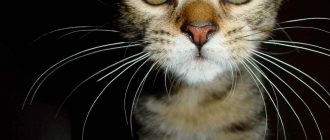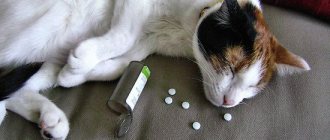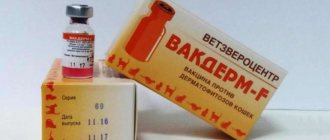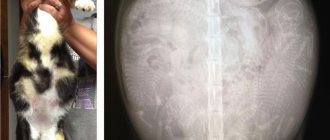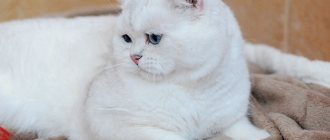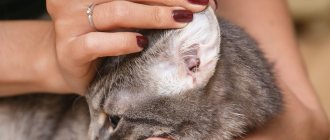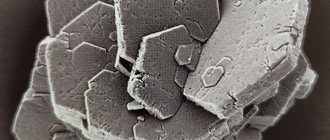A domestic cat that has matured sexually is ready to mate with the opposite sex and bear offspring. The period of sexual heat in a cat is called estrus and indicates the cat’s readiness to procreate. A cat becomes sexually mature at the age of 10-12 months. This applies to cats with low levels of sex hormones - less temperamental.
There are cats with high levels of sex hormones and increased activity. In such pets, sexual heat begins much earlier. Veterinary medicine has described cases where a cat became ready to reproduce at the age of 4.5 months. What is noteworthy is that a fertilized cat at such an early age can become pregnant.
Opposite cases have also been described, when a seemingly physically healthy cat does not shed at the age of 18-24 months. All these are deviations from the norm and may indicate the presence of serious disruptions in the hormonal system. Professional breeders do not recommend future breeding of cats whose estrus occurs early. Such animals are culled and sterilized. This is due to the fact that there is an assumption about genetic inheritance in the area of the onset of sexual hunting.
Veterinary experts recommend performing surgery to remove the reproductive organs of cats whose owners do not want to receive offspring from her in the future. Empty heats in an animal (without natural fertilization) can negatively affect the cat’s condition in the future.
As a result of empty estrus, diseases of the uterus develop that are purulent in nature. Without the timely intervention of a veterinary specialist, the pet may die. Early, timely sterilization allows you to avoid serious complications in the future. This is a better solution than constantly enduring the cat’s sexual desire, as well as giving hormonal drugs that prevent and suppress estrus.
Puberty and the cat cycle by stages
Puberty occurs the day cats go into their first heat. Most often this occurs between 7 and 12 months of age. The following factors influence the time of growing up:
- Breed
. In addition to the onset of sexual maturity, breed affiliation determines the characteristics of the course of estrus.
- Cohabitation with animals of the opposite sex
. Kittens from the same litter living together mature at 4-5 months.
- Genetics
. The approximate age of maturity can be determined by the mother of the kittens.
It is impossible to calculate the exact day, since all animals are unique. The only cause for concern is a serious deviation from the average guidelines.
The cat's reproductive cycle consists of 4 stages:
- Proestrus
. The darling is not yet ready to mate, so she drives the cats away. She becomes more affectionate only towards her owner. The duration of this stage is 1-4 days.
- Estrus
. Noticeable discharge appears. Due to raging hormones, the pet screams at night, preventing its owners from sleeping. After stroking, she raises the back of her body, taking a characteristic mating position. This period lasts 5-7 days and is suitable for procreation.
- Metestrus
. After mating, pregnancy occurs at this stage, and sometimes, in its absence, pseudopregnancy. The aggressive attitude towards the opposite sex returns. The duration of the stage is 2-12 days.
- Anestrus
. By the final phase, the animal’s condition stabilizes. A cat's new heat occurs after 3 weeks or several months.
A peculiarity of cat physiology is the absence of ovulation when refusing mating. Without vaginal stimulation, the egg remains in its place.
Medications to calm cats
In addition to all of the above, you can use the following tools:
Cat Bayun is a drug aimed at correcting a cat’s behavior. It is available in the form of tablets and drops, and the product is completely safe for your pet. The composition is represented by natural ingredients (roots of peony, lemon balm, St. John's wort, thyme, sweet clover, valerian and oregano);
Fospasin - used both as injections and drops. The drug alleviates the emotional and psychological state of the animal. The substances contained in Phospasin do not accumulate in the pet’s body, which prevents the occurrence of negative consequences for the cat;
Bach drops - the product does not contain any additives of artificial origin. The drug helps calm the pet without having a depressant effect on its nervous system. The drops do not have a hypnotic effect. Any of the described remedies and injections calms the animal, but the process of estrus does not stop.
Cat's first heat
The first estrus is exciting for both the owner and the animal. The time of its onset and characteristic symptoms largely depend on the breed.
At what age does it start
In addition to the breed, genetics and the fact of cohabitation with a cat, sexual maturity depends on several other factors. These include:
- Location
. Pets take longer to mature than street animals. Lighting at home is also important, stimulating the activity of sex hormones.
- Time of birth
. Pets born in the fall are inferior in speed to those born in the spring.
- Animal size
. Those with small dimensions are ahead of larger representatives.
- Body mass
. Too much or too little weight prevents timely maturation.
- Wool length
. The shorter the coat, the earlier sexual maturity will occur. Orientals and Abyssinians mature at 5 months, British and Scottish females at 8-12 months, and fluffy Siberians, Ragdolls and Maine Coons at 9-15 months.
Please note that puberty is not the same as physiological maturity. It is strictly forbidden to breed your pet for the first heat.
Characteristic manifestations
Before menstruation is about to begin, the pet begins to roll on the floor and rub against the owner’s legs, trying to attract his attention. After stroking the back, she lifts the back of her body, moves her tail and fussily moves her paws.
To attract a cat, the kitty meows long and loudly or purrs intensely. She can start her songs at any time of the day, which really bothers the owners who are trying to get some sleep before work. Trying to find a mating partner, the pet may attempt to escape. During this period, you will have to keep the doors and windows closed.
In addition to behavioral changes, consider physiological characteristics. These include:
- decreased appetite;
- increase in vaginal size;
- prolonged licking of the perineum due to increased urination;
- the appearance of transparent discharge.
The first “critical days” are almost invisible. This is due to the fact that physiologically the animal continues to develop. More distinct signs appear the second time.
Features of the first estrus
Maine Coon sexual heat is accompanied by strong thirst and indifference to food. Their growth temporarily stops, so don't be alarmed by the lack of change.
British women often change their mood, alternating affection with aggression. But with the sphinxes everything is stable. Owners will have to put up with their loud screams, irritability and completely uncontrollable behavior.
Siamese are the quietest. Thanks to their calmness, “critical days” can be recognized only by physiological signs. Scottish women are no less calm - they do not shout loudly and do not stand in a characteristic pose. Only excessive affection gives them away.
These signs may not appear - after all, each cat’s body and temperament are individual. You may “get” a loud Siamese or a very quiet and affectionate sphinx lady.
What should a cat owner be wary of?
When your pet shows the first signs of the onset of estrus, there is no need to immediately stuff her with hormonal drugs. Of course, such drugs act quite effectively. Nevertheless, you need to remember about their negative impact on the pet’s body. The use of such drugs can lead to disruption of the animal's hormonal levels.
In turn, this can cause the formation of tumors of the ovaries and uterus at absolutely any age. A cat's first heat can occur at 7 months of age. True, in some animals this process can begin much later. Regardless of the age of onset of estrus, your pet should not be immediately introduced to the cat. This is due to the fact that the pet’s young body is not yet fully formed. Otherwise, early pregnancy can cause a number of serious complications.
Despite the “terrible” behavior of a cat during heat, shouting at her, much less hitting her, is strictly prohibited. The animal is simply not able to independently control its behavior, but it still recognizes and experiences the feeling of guilt. In the case of regular screaming or even beating, the pet may receive psychological, irreparable trauma.
Periodicity of estrus
There is no clear answer to the question of how often cats go into heat. The frequency is individual and depends on the following factors:
- Breed
. Persians, Orientals and Siamese women flow more often than British and Scottish women. For the latter, the break can be up to 5-8 months.
- Presence of pregnancy
. Cat menstruation returns to its usual schedule only 1.5-3 months after birth. An earlier return is possible in case of death of the litter or separation from the kittens immediately after birth.
- Age
. The younger the animal, the more often it is ready to mate.
- Season
. The breaks shorten from early spring to mid-autumn and increase with the arrival of winter. This is due to the fact that in the warm season it is easier to carry and give birth to healthy offspring. The exception is pets who do not leave the apartment for a year. Thanks to comfortable living conditions, their schedule does not change.
- Breeding frequency
. Rare meetings with representatives of the opposite sex reduce the period of calm to 2 weeks. If mating is too frequent, the opposite is true - constant mating reduces the number of menstruation to 2 times a year.
On average, estrus occurs 4 times a year, that is, once a quarter. But for some, this process can occur every 3 weeks or once every six months. In the absence of pathologies of the reproductive system, this is completely normal.
Preventive actions
If you want to have a pet, it is recommended to experimentally test the reaction of your body and household members for the presence of allergies. For example, visit acquaintances or friends who already have a cat or cat. It is better if the communication is long and not five minutes, since an allergic reaction may not appear immediately. If after the experiments no signs of allergy were observed, then with a high degree of probability we can talk about its absence.
If you know that you are prone to an allergic reaction, but your love for cats does not allow you to completely give up your pet, then before getting a kitten, you need to carefully choose the breed. Hypoallergenic breeds will make the life of an allergy sufferer much easier.
But what if you already have a cat and are later diagnosed with an allergy? In this case, to reduce allergy symptoms and maintain a normal state, the following preventive measures must be taken:
- minimize direct contact with the animal if possible;
- take special anti-allergenic drugs;
- bathe the animal, and then comb the fur at least once a week (if possible, this should be entrusted to household members who do not suffer from allergies);
- If possible, remove as much as possible carpets, rugs, blankets and other soft coverings that can accumulate wool;
- regularly ventilate the premises;
- Do not leave personal items and items of your wardrobe in a place accessible to the animal.
Duration of “critical days”
The average duration of “critical days” is 5-7 days, but sometimes it can last up to 14-20 days. Due to the variety of factors influencing this process, it is almost impossible to determine how long a cat's first heat will last. Most often it goes faster, but it is better to start from average indicators.
If sexual activity exceeds 3 weeks or lasts less than 5 days, take your pet to a veterinary clinic for diagnosis. In the first case, there is a possibility of developing tumors or inflammation in the ovaries, and in the second - pathologies of the thyroid gland or ovarian hypoplasia.
Anti-estrus medications
Yes, there is a hormonal injection ( Covinan ), the introduction of which can stop estrus and prevent its occurrence for an average of six months.
Please note that it is highly undesirable to use such a drug without consulting a veterinarian.
Firstly, these injections must be given strictly according to the scheme, not just once, but over several months.
Secondly, the drug can only be used before the onset of estrus.
The use of hormonal injections during estrus is strictly contraindicated.
Please take into account the fact that the first injection of this drug should be given ONLY by a veterinarian, explaining the further regimen of use.
Do not forget about the high risk of diseases of the uterus, appendages and mammary glands of your pet. This medication is contraindicated for use in cats over 5 years of age, especially if it has never been used on your cat before.
Signs of estrus
To attract males, females use 2 tools: voice and smells. All sounds made become rougher and louder. Frequent but light urination occurs not only in the litter box - the pet leaves odorous marks on vertical and horizontal surfaces. Raising her tail and turning her back towards the target, she secretes a few drops of urine.
Another way to place marks is by rubbing them on objects. The glands on the cheeks of furry pets secrete a special secretion, allowing them to leave an individual scent.
The signs of the first menstruation are identical to subsequent ones. They are distinguished only by their weak expression in young animals.
Remember that discharge during “critical days” should be transparent. The appearance of blood or pink clots is a dangerous symptom that requires diagnosis.
Discharge during estrus
During sexual heat, it is necessary to monitor the nature of the discharge. As already said, they should be transparent and insignificant. You should consult a doctor if the secretion has acquired a red or white tint. This is how some diseases of the reproductive system manifest themselves - vaginitis, pyometra, hydrometra, endometritis and even malignant processes.
Discharge may indicate diseases of internal organs
How to calm a cat
Having figured out how to understand that a cat has gone into heat, it remains to figure out what to do if the owner does not want to endure constant nightly arias. There are only two cardinal solutions: pregnancy and sterilization. The operation not only suppresses sexual desire, but also prevents the development of cancer.
When choosing regular matings, unwanted behavior goes away only temporarily, so to calm your pet you will have to resort to medications, changes in activity and diet.
Change of activity and food
Aggression and increased activity can be directed towards toys. Long games use up increased energy reserves and normalize night sleep. Try to distract your pet during the daytime sleep to exhaust him by nightfall. Also, do not forget about increased attention. Talk and pet your pet more often. Your love will help reduce your stress levels.
Another trick to ensure long sleep is abundant feeding later in the day. Temporarily limit constant access to the feeder and give out food strictly on a schedule. After a night of feasting, all energy will be spent on digestion, and not on concerts.
Remember that with an increase in the evening portion, the volume of the daily ration remains unchanged. Otherwise, there is a risk of obesity. Meals should be small and easily digestible so as not to overload the gastrointestinal tract.
Sedatives
Veterinarians recommend sedatives made from herbal preparations (Cat Bayun, Stop-Stress). They are not addictive and do not have severe side effects. Their only contraindication is the presence of an allergy to one of the components.
Hormonal drugs
Taking hormonal medications (Stop-Intim, Sex-Barrier) is possible only as prescribed and under the supervision of a veterinarian. These medications directly affect hormonal levels, which can trigger the development of pathologies of the ovaries and uterus, including cancer.
With the constant use of hormones, 70% of animals endure forced sterilization for medical reasons. It is much safer to deprive your pet of reproductive function soon after puberty.
What not to do
Please note that traditional methods of calming are not only cruel and senseless, but also dangerous. Avoid raising your voice or using physical punishment. Compliance with this rule is the key to a strong and respectful relationship with any pet. Don’t try to judge your pet for nighttime insomnia and leaving marks - all this happens not out of malice, but under the influence of hormones.
Do not cool your genitals with ice water. This will not only frighten the animal, but can also cause inflammation.
Don't try to lock your pet in a dark room. The sun's rays do stimulate hormones, but staying in a confined space for a long time will only lead to mental disorders.
Deviations from the norm
For most pets, estrus is calm and painless. However, some cats are susceptible to hormonal imbalances or have a predisposition to abnormalities.
Prolonged heat
This refers to estrus that has lasted for more than 14 days. The phases of the physiological process are extended, going beyond a certain norm. At this time, mucous discharge does not stop, but at the same time the cat is aggressive and does not allow the cat to approach, so fertilization does not occur.
Anaphrodisia
This is the complete absence of any signs of estrus in an adult cat. A delay in normal puberty is accompanied by a similar deviation. In any case, the animal must be shown to a competent veterinarian, who will prescribe treatment.
False pregnancy
If fertilization does not occur, but all the symptoms of pregnancy are present, a false pregnancy appears. The pathological condition is determined by the doctor.
Some breeds, such as Sphynxes, have a predisposition to such manifestations. In most cases, it is still a psychological problem that develops due to stress.
The animal's behavior also changes. The cat looks for a secluded place, often carries soft objects in its teeth, considering them its children, while its stomach and mammary glands swell, its appetite and thirst increase. The pathological condition is dangerous due to the development of a complication – purulent mastitis.
Empty heat
This is a situation when the estrus has ended, but the pet has not become pregnant. This condition is dangerous due to the development of ovarian cysts, inflammatory processes in the reproductive system and even cancerous tumors.
If the owner does not plan to go through the procedure of mating animals, it is better to immediately sterilize the pet.
Bloody issues
According to the norms, a cat should not have bloody inclusions in its discharge. If such a phenomenon was noticed by the owner, it is better to immediately show the animal to an experienced veterinarian to determine the problem.
How and when to mate
The first mating is carried out on the third menstruation, when the pet has reached physiological maturity. This reduces the risk of miscarriages, infertility and other complications.
Before meeting her partner, the “bride” is vaccinated and dewormed. Her nails are trimmed and a set of personal items is collected that she will need while away from home. Mating is carried out on the male's territory to reduce his excitement.
The animals are left alone for several days to repeat cages many times. This consolidates the result, increasing the chances of successful fertilization. Help from the owners is required only in cases of aggressive behavior, discrepancies in the size of the partners, and the cat falling on its side.
Empty estrus in a cat and constant use of hormonal drugs have a negative impact on health. If there is no labor, sign up for sterilization.
Can a spayed cat go into heat?
It all depends on the type of operation chosen. Most often, females are not sterilized, but castrated. These operations are often confused, suggesting that the latter is performed only on males. In fact, sterilization is a tubal ligation that prevents fertilization. A neutered female cat will not be able to give birth to kittens, but will still want to mate due to the influence of hormones.
Changes in hormonal levels can only be achieved by castration. The operation is divided into 2 types:
- oophorectomy, which involves removing the ovaries and preserving the uterus;
- ovariohysterectomy, which involves the removal of all reproductive organs.
The first method reduces the risk of developing polycystic disease and breast tumors, but does not protect against uterine cancer. For this reason, the second method is more reliable.
For simplicity, veterinarians may use the same terms as owners. Before the operation, be sure to discuss the purpose and method of surgery to avoid misunderstandings.
Estrus after sterilization
This phenomenon occurs infrequently. The main reasons are:
- Reminent ovarian syndrome is a pathology in which ovarian cells settle in the wrong place during the intrauterine formation of the fetus. During surgery, the tissue may not be noticed: it is difficult to detect.
- A tumor of internal organs (adrenal glands, breast, cyst on the uterus) that produces hormones.
- The adrenal glands have taken over the tasks of the gonads.
- Activity of pituitary hormones.
- Long-term attenuation of hormonal levels, especially if sterilization was carried out during the period of estrus.
- Preserved ovarian tissue, or ovarioreminant syndrome, which develops if not all cells of these reproductive organs are removed from the body.
If your cat is in heat after sterilization, you should contact your veterinarian. He will diagnose and prescribe appropriate treatment. In some cases, repeated surgery is indicated.

